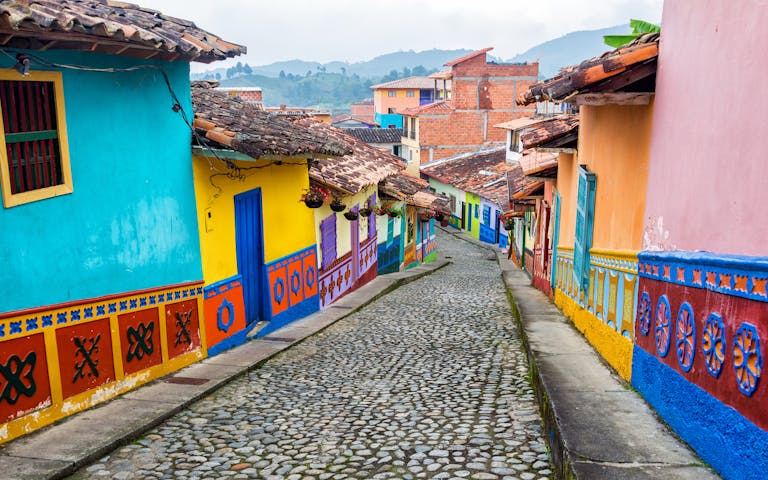The most bio-diverse place on earth per square inch, Colombia is a natural paradise of unbelievable proportions that also happens to be home to some of the best cannabis heirloom strains on earth. The country was shipping cannabis to the USA back in the 60s and 70s, before black market production moved up to Mexico, and several potent landraces were developed during that time. In the last few years, the country has been shifting away from its former Drug War-style prohibition and has legalized medical cannabis. With breathtaking white sand Caribbean beaches, hip and artistic cities, postcard-perfect historic mountain towns, an incredible music scene, and world-class archaeological sites, Colombia is the most dynamic and exciting cannabis travel destination on the globe right now.
Yet as medical legalization has been implemented, Colombia has also begun to crack down on small growers while starting to license larger corporate operations; for instance, the government just granted Canadian corporation PharmaCielo rights to set up a major production and exportation facility near Medellín. Locals tell me they fear crackdowns on small operations; in fact, last year it was actually harder to get cheap natural cannabis in the larger cities than it was when everything was illegal.
While the country’s down-to-earth cannabis culture continues to endure, politics and big business could start to change that in the coming years. As such, now is the best possible time to witness the magical realism of Colombia’s gorgeous landscapes and soak in its one-of-a-kind cannabis culture while it’s still thriving. Best of all, cannabis is easy to get anywhere in the country. Below, learn where to go when you visit this green-friendly getaway: Each one is a cannabis connoisseur’s mecca in its own right.

The Lost City, in the Sierra Nevada de Santa Marta mountain range, is considered Colombia’s own Machu Picchu.
Much of this fantastical upper landscape is off-limits and run by the autonomous Kogi Indians, but the trek to the Lost City, which takes five days and winds deep into the rainforest covered mountainside, is considered Colombia’s own Machu Picchu and is well worth the effort. These forested mountainsides are still major coca growing regions, and some Lost City treks stop at processing facilities as part of the tour, but the mountains are also a major growing area of Colombian Gold, an awesome old-school sativa heirloom strain that gives a deep and energizing buzz. Other strains growing in the Santa Marta area include Limón Verde, which has a citrusy bite and an uplifting quality, and my personal favorite, Punto Rojo (Red Point), another classic that is related to Panama Red.
Just outside of Tayrona National Park lie several beach towns where backpackers put in serious down time against one of the most stunning backdrops on earth. Taganga, once a simple fishing village but now an international globetrotter rest stop, sits under a cloud of permanent cannabis smoke, while on the other side of Tayrona more chilled-out beach scenes await in towns like Palomino. The winning combo of some of the most stunning beaches on earth and plentiful quantities of top-quality organic bud makes Tayrona National Park as close as it gets to a marijuanero’s paradise.

Although not near a major growing area, Bogotá is the place where most of Colombia’s cannabis innovation is going on. A stroll through the city’s historic core, La Candelaria, will lead to several head shops including Ina Jah located right below the Chorro de Quevedo, the oldest plaza in the city and a gathering place for tokers day and night. The yearly Carnaval Cannábico Bogotá, or Cannabis Carnaval, completely takes over the city’s central Parque Nacional before marching on the palace of the president himself. It is an endless display of sprays, salves, alcohol-infused cannabis shots and more, all handmade by the local creative class and going for incredibly cheap prices. Different herb from all over the country is sold on the street in the capital, including the delicious Mango Biche (Green Mango)—although there’s plenty of highly-processed corporate cannabis trying to grab market share in the city at the moment, too.

In Bogotá, chefs and bakers craft exceptional edibles sold openly on the streets of La Candelaria. (Courtesy of Ocean Malandra)
To me though, the most impressive thing about Bogotá is the edibles scene, which is truly cutting-edge with a huge number of exceptionally talented bakers and chefs getting in on the game. Delicious cookies, brownies, and more are sold openly on the street in La Candelaria daily, as well as at the big Sunday farmers market and artisan fair in Usaquén. Find a producer you like and follow their Facebook page to keep up with their offerings. I personally love the Gato Callejero with his potent Snickers brownies—you can even get them delivered to your hotel room.
A trip up the cable car to the mountaintop sanctuary and mirador of Monserrate for panoramic views over Bogotá is mind-blowing under the influence of a little herb, and perusing the intricate 14-karat gold artistry of the ancient Muisca civilization at the Museo del Oro (Gold Museum) becomes even more fascinating when you are wearing your Mary Jane shoes.

Hiking to the various waterfalls and archaeological sites in this lost-in-time fairyland under the influence of some local Punto Rojo is the highlight of many people’s entire trip to Colombia, and the town has attracted a large permanent population of expats who simply cannot give up the lifestyle. In addition to cheap backpacker-style accommodations in the cobblestone-paved town itself, San Agustín is home to a dozen or so low-profile, villa-style hotels on its outskirts, like La Casa de François, where roses bloom among the flowering cannabis and life slows itself to a standstill.

Word to the wise: The rainforest-carpeted crags of the Farallon Mountains, which provide an exotic backdrop to Cali’s otherwise drab appearance, are a hot narco-trafficking zone, so don’t go wandering around in the mountains alone. There’s no reason to: Some of the best-quality cannabis in the country is readily available, including a local strain called Corinto, which is sweet, smooth, and named for a nearby town where much of the herb is processed. Corinto is sold abundantly all over Cali, including in pre-rolled joints right in San Antonio Park, a leafy vista point that looks out over the city skyline and fills with couples and families most nights of the week. This colonial area is also a good place to find a bed and breakfast or inexpensive hostel in historic digs.
With an elevated mind, Cali-style salsa is quite simply out of this world.
Cali is known throughout Latin America as the capital of salsa, and you won’t enter a taxi, restaurant, or even a bank in this tropical city without hearing its syncopated beat vibrating through the air. Like jazz in the US or reggae in Jamaica, the salsa in Cali is driven in part by the city’s strong cannabis culture, and some of the best dancers I know always puff on a pre-roll before tearing up the floor.
With an elevated mind (or without), Cali-style salsa is quite simply out of this world. To see this pure joy in motion for yourself, head outside of the city limits to Juanchito, where salsatecas that have been grooving since the 60s, including the mighty Chango, stay packed until the sun comes up.
Additional image credits:
Header: DC_Colombia/iStock
Tayrona: SL_Photography/iStock
Bogotá: Courtesy of Ocean Malandra
San Agustín: DC_Colombia/iStock
Cali: Tiago_Fernandez/iStock






